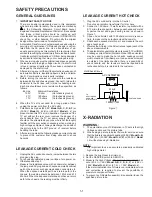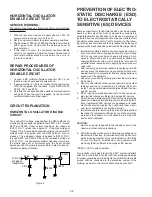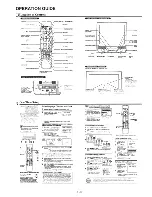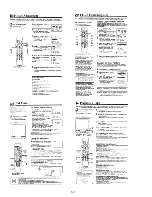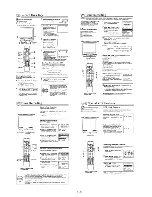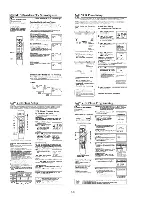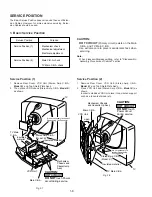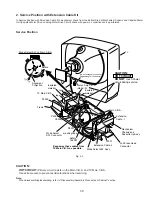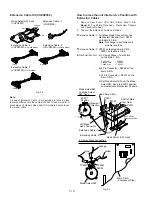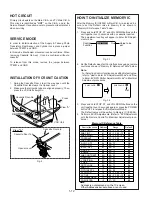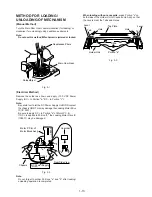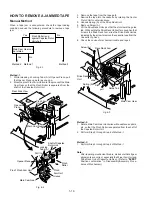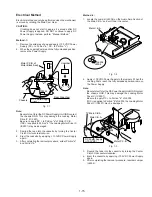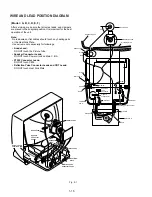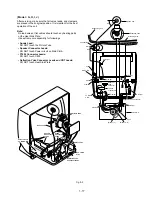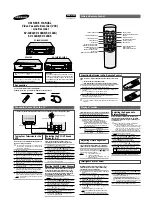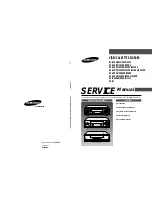
1-2
IC5301
11
+
-
+
-
R5505
R503
D503
C513
C5507
To Pin 5
of Flyback
Transformer
R5504
PREVENTION OF ELECTRO-
STATIC DISCHARGE (ESD)
TO ELECTROSTATICALLY
SENSITIVE (ES) DEVICES
Some semiconductor (solid state) devices can be damaged
easily by static electricity. Such components commonly are
called Electrostatically Sensitive (ES) Devices. Examples of
typical ES devices are integrated circuits and some field-effect
transistors are semiconductor "chip" components. The follow-
ing techniques should be used to help reduce the incidence of
component damage caused by electrostatic discharge (ESD).
1. Immediately before handling any semiconductor compo-
nent or semiconductor-equipped assembly, drain off any
ESD on your body touching a known earth ground. Alter-
natively, obtain and wear a commercially available dis-
charging ESD wrist strap, which should be removed for
potential shock reasons prior to applying power to the unit
under test.
2. After removing an electrical assembly equipped with ES
devices, place the assembly on a conductive surface such
as aluminum foil, to prevent electrostatic charge buildup or
exposure of the assembly.
3. Use only a grounded-tip soldering iron to solder or unsolder
ES devices.
4. Use only an antistatic solder removal device. Some solder
removal devices not classified as "antistatic (ESD pro-
tected)" can generate electrical charge sufficient to dam-
age ES devices.
5. Do not use freon-propelled chemicals. These can gener-
ate electrical charges sufficient to damage ES devices.
6. Do not remove a replacement ES device from its protective
package until immediately before you are ready to install it.
(Most replacement ES devices are packaged with leads
electrically shorted together by conductive foam, alumi-
num foil or comparable conductive material).
7. Immediately before removing the protective material from
the leads of a replacement ES device, touch the protective
material to the chassis or circuit assembly into which the
device will be installed.
CAUTION:
Be sure no power is applied to the chassis or circuit, and
observe all other safety precautions.
8. Minimize bodily motions when handling unpackaged re-
placement ES devices. (Otherwise harmless motion such
as the brushing together of your clothes fabric or the lifting
of your foot from a carpeted floor can generate static
electricity (ESD) sufficient to damage an ES device).
"NOTE to CATV system installer :
This reminder is provided to call the CATV system installer's
attention to Article 820-40 of the NEC that provides guidelines
for proper grounding and, in particular, specifies that the cable
ground shall be connected to the grounding system of the
building, as close to the point of cable entry as practical."
HORIZONTAL OSCILLATOR
DISABLE CIRCUIT TEST
SERVICE WARNING :
The test must be made as a final check before set is returned
to the customer.
1. With the rear cover removed, supply about a 120V AC
power source to the set, turn on the set.
2. Set the customer controls to normal operating positions.
3. Short between TP891 and TP892 on the Main circuit board
with a jumper wire. Confirm that the picture goes out of
horizontal sync.
4. If this does not occur, the horizontal oscillator disable
circuit is not operating. Follow the Repair Procedures of
horizontal oscillator disable circuit before the set is re-
turned to customer.
REPAIR PROCEDURES OF
HORIZONTAL OSCILLATOR
DISABLE CIRCUIT
1. Connect a DC voltmeter between capacitor C513 (+) on
the Main circuit board and chassis ground.
2. If approxi21.9V is not present at that point when
120V AC is applied, find the cause. Check R503, R5505,
C5507, C513 and D503.
3. Carefully check above specified parts and related circuits
and parts. When the circuit is repaired, try the horizontal
oscillator disable circuit test again.
CIRCUIT EXPLANATION
HORIZONTAL OSCILLATOR DISABLE
CIRCUIT
The positive DC voltage, supplied from the D503 cathode for
monitoring high voltage, is applied to the IC5301 Pin11 through
R503 and R5504. Under normal conditions, the voltage at
IC5301 Pin 11 is less than approx 3V. If the high voltage at
Flyback Tr Pin 5 exceeds the specified voltage, the positive DC
voltage which is supplied from the D503 cathode also in-
creases. The increased voltage is applied to IC5301 Pin11
through R503 and R5504. Due to the increased voltage at
IC5301 Pin11, the horizontal oscillator frequency increases,
the picture goes out of horizontal sync, the beam current
decreases and the picture becomes dark in order to keep X-
radiation under specification.
Figure 2
Содержание Omnivision PV-M1378W
Страница 5: ...1 3 ...
Страница 6: ...1 4 ...
Страница 7: ...1 5 ...
Страница 8: ...1 6 ...
Страница 60: ......
Страница 61: ......
Страница 62: ......
Страница 63: ......
Страница 64: ......
Страница 65: ......
Страница 66: ......
Страница 67: ......
Страница 68: ......
Страница 69: ......
Страница 70: ......
Страница 71: ......
Страница 72: ......
Страница 73: ......
Страница 74: ......
Страница 75: ......
Страница 76: ......
Страница 77: ......
Страница 78: ......
Страница 79: ......
Страница 80: ......
Страница 81: ......
Страница 82: ......
Страница 83: ......
Страница 84: ......
Страница 85: ......
Страница 86: ......
Страница 87: ......
Страница 88: ......
Страница 89: ......
Страница 90: ......
Страница 91: ......
Страница 92: ......
Страница 93: ......
Страница 94: ......
Страница 95: ......
Страница 96: ......
Страница 97: ......
Страница 98: ......
Страница 99: ......
Страница 100: ......
Страница 101: ......
Страница 102: ......
Страница 130: ...Printed in Japan ...



